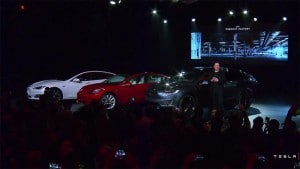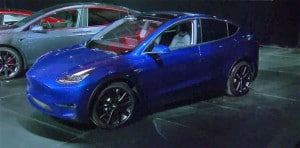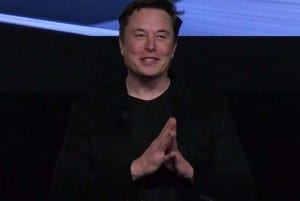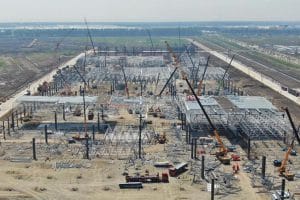
Tesla sales are expected to come in flat in 2019, despite a strong finish to the year by the new Model 3.
Tesla is far and away the leader in the U.S. battery-electric vehicle, or BEV, market, outselling all of its competitors combined.
But, even as the California automaker ramps up production in China and gets ready to start building a new plant near Berlin, a look back at 2019 could be seen as an ominous warning. After years of aggressive sales growth that accelerated rapidly with the 2018 launch of the Model 3 sedan, Tesla sales all but flattened last year, demand for its older Models S and X tumbling rapidly.
Tesla had to cope with the phase-out of its federal tax incentives during 2019, the credits offered buyers eliminated as of the beginning of this month. It’s unclear what impact that could have on demand. Meanwhile, the Model Y SUV that the company hopes will be even a big sales driver than the Model 3 sedan isn’t likely to reach showrooms until late 2020.
(Tesla denies problems with unintended acceleration)
Even as Tesla sales flattened, new competitors entered the battery-car market, while others updated existing products. Combined sales of products like the Nissan Leaf, Audi e-tron and Jaguar I-Pace didn’t come close to matching Tesla’s total and, if anything, generally lagged expectations. But they did manage to grow faster than their California rival, in the process trimming Tesla’s overall market share.

The Model Y, shown here at its debut, will be critical to Tesla’s success – and Musk’s next big payday.
The Model Y is expected to draw significant interest, CEO Elon Musk forecasting demand could double that of the Model 3 sedan in an SUV-centric market. But Tesla will face more competition than ever this year, with significant new entries coming in 2020 – such as the Porsche Taycan, Ford Mustang Mach-E, Volkswagen ID.4, Mini-E and an as-yet-unnamed Cadillac SUV.
“Tesla has grown fast at various points in the past, and it may do so again in 2020 – but in 2019 it grew only 0.3% in the U.S. and lost ground to most major competitors,” said EV market analyst Anton Wahlman, and the question is whether or not it will regain its momentum this year.
The answer to that question – indeed, the official final numbers for the final quarter of 2019, along with the results from the current three-month period – could be critical. Tesla has more than doubled its stock price during the past three months, shares going for somewhere around $544 during late Tuesday afternoon trading. That is a gain of more than $33, or 6.5% for the day, nudging close to the company’s all-time record.
Tesla has yet to reveal official sales figures for the October-December period, but InsideEVs.com estimates the U.S. numbers rose a modest 0.3%, to 192,250 units for all of last year, up from 191,687 in 2018.

Tesla CEO Elon Musk helms the largest EV maker in the U.S., as the company outsold all of its competitors combined.
(Tesla buys German gigafactory site for $45 million)
The overall U.S. BEV market rose 3% in 2019, to 243,356, reported InsideEVs. A quick check of the calculator shows that all other manufacturers sold 51,106 battery-electric vehicles during that period, an increase of nearly 16 percent.
Tesla still has plenty to crow about, considering it ended the year with a stunning 79% share of the U.S. BEV market. But the trend line should, nonetheless, be of concern. That’s all the more apparent when looking at fourth-quarter results. The battery-car publication said overall BEV sales of 70,392 were down 22% for the period. That was entirely attributable to Tesla as the manufacturer’s sales of 56,525 vehicles were down 27% year-over-year. Non-Tesla BEVs, by comparison, rose 6% for the period, to 13,867.
What’s particularly notable about the Q4 slide at Tesla is that the automaker still had some incentives to offer during that three-month period, albeit at just a quarter of the original $7,500 available before its U.S. sales crossed the 200,000 threshold set by Congress. It remains to be seen if the elimination of the last $1,750 in givebacks will have any impact on first-quarter and subsequent demand.

The Gigafactory 3 took just 10 months to go from empty field to production-ready operation. Will the new plant in Germany go up just as quickly?
On the plus side, the Tesla Model 3 retained positive growth in the U.S. through the end of 2019, sales for the final quarter growing 14%, to 158,925. But demand for the Model S was off a sharp 45%, while the Model X was off by 26%, according to InsideEVs.
The company clearly needs the Model Y, according to Wahlman and other analysts, but it is more than half a year away from launch — although some speculate Musk might offer up a positive surprise and bring it to market sooner than expected.
However, when it does hit the streets, it will face some tough new competition. Ford, in particular, is claiming solid advance demand for the Mach-E, the First Edition version supposedly sold out. Along with established automakers entering the market, there will be a number of new competitors aiming to launch in 2020 and the following year, including Fisker, Lucid, Rivian, Bollinger and Faraday Future.
(CEO Musk Says Teslas Going to be Pricier in the Future)
The good news for Tesla is that it is becoming less focused on the home U.S. market. It is ramping up production at its new Shanghai assembly plant – though the Chinese plug-in vehicle market took a rare tumble in 2019 – and it this week announced the location of the new assembly plant it will build in Berlin. Looking beyond the Model Y, it has an assortment of new products to follow, including the Cybertruck pickup, the second-generation Roadster and the big Semi truck, that could add even more momentum at home and abroad.
